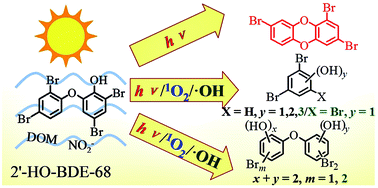Distinct photoproducts of hydroxylated polybromodiphenyl ethers from different photodegradation pathways: a case study of 2′-HO-BDE-68†
Abstract
Hydroxylated polyhalodiphenyl ethers (HO-PXDEs) are emerging aquatic pollutants. Previous studies have shown that HO-PXDEs can photogenerate dioxins and phenolic compounds. However, it is unclear which photochemical pathways are responsible for the various photoproducts. This study investigates the direct photolysis and photooxidation initiated by 1O2 and ˙OH that can be formed by photosensitization, taking 2′-HO-2,3′,4,5′-tetrabromodiphenyl ether (2′-HO-BDE-68) as a case study. The results show that 1,3,8-tribromodibenzo-p-dioxin can only be produced during direct photolysis. By mass spectrum analysis, four dihydroxylated polybromodiphenyl ethers, generated from both direct and indirect photodegradation were confirmed. Among them, di-HO-tribromodiphenyl ether (di-HO-TBDE) was the main product generated from direct photohydrolysis. Most probably, the di-HO-TBDE is 2′,5′-HO-2,3′,4-tribromodiphenyl ether, as was suggested by density functional theory calculations. Ether bond cleavage is a dominant pathway for the direct photolysis and photooxidation reactions leading to 2,4-dibromophenol as the dominant product. The yields of the products, which are irrespective of reaction time and can be employed to compare the ability of different HO-PXDEs to photogenerate a given product, were reported. This study indicates that for accurate ecological risk assessment of HO-PXDEs, their different photodegradation pathways that may lead to different photoproducts should be considered.


 Please wait while we load your content...
Please wait while we load your content...